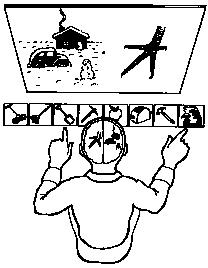 Top Row: The command "Laugh" was flashed to the left field of
vision (right hemisphere), and the subject laughed. When asked, "Why are you
laughing?", the subject said, "Oh...you guys are really something."
Top Row: The command "Laugh" was flashed to the left field of
vision (right hemisphere), and the subject laughed. When asked, "Why are you
laughing?", the subject said, "Oh...you guys are really something."
 When
a split brain subject is subjected to tests where the left half of their brain
does not know the correct answer, it will often make something up based on the
information it does have.
When
a split brain subject is subjected to tests where the left half of their brain
does not know the correct answer, it will often make something up based on the
information it does have.
In this particular test, each hemisphere was simultaneously presented with a different cognitive test. Each hemisphere was presented with a picture and told to pick the object which relates to that picture. The left hemisphere was shown a chicken claw, while the right viewed a snow scene. You can see that the patient is pointing to a chicken with his right hand, and a shovel with his left. After each hemisphere responded, the left hemisphere was asked to explain its choices. The way the subject verbally interpreted the double field stimuli is of particular interest. When asked what images he saw on the screen, the patient responded, "I saw a claw and I picked the chicken, and you have to clean out the chicken shed with a shovel."
Trial after trial, this kind of response occurred. The left hemisphere could easily and accurately identify why the right hand chose the corresponding picture that it had, and then subsequently, and without batting an eye, it would incorporate the right hemisphere's response into the framework. While observers knew exactly why the right hemisphere and made its choice, the left hemisphere could merely guess. What is interesting is that the left hemisphere did not offer its suggestion in a guessing vein but rather as a statement of fact.
This cartoon illustrates another experiment done with a split brain subject
in which the left hemisphere compensates without the person being aware what is
going on.  Top Row: The command "Laugh" was flashed to the left field of
vision (right hemisphere), and the subject laughed. When asked, "Why are you
laughing?", the subject said, "Oh...you guys are really something."
Top Row: The command "Laugh" was flashed to the left field of
vision (right hemisphere), and the subject laughed. When asked, "Why are you
laughing?", the subject said, "Oh...you guys are really something."
Middle Row: The command "Rub" was flashed to the right hemisphere and the subject's left hand scratched the back of the right hand. When asked what the command was, the subject said, "Oh...itch."
Bottom Row: The instructions are "Assume the position of the flashed word." The word flashed was "Boxer." The subject clinched both fists and held them in a ready position. "What was the word?" "Oh...boxer."
The left hemisphere proved extremely adept at immediately attributing cause to the action. The subject could not truly say why they were laughing, for the left hemisphere had not received any information from the right that the command laugh had been flashed. The subject's left hemisphere evaluated the response and characterized it. It compensated for it's lack of knowledge by calling upon previous experiences in which laughing was an appropriate response and said, "Oh...you guys are really something".
When the patient tried to explain why she was rubbing the back of her right hand, her left hemisphere again tried to compensate for the lack of knowledge, suggesting to her that she had an itch. The fact that she said "itch" instead of "rub" shows that she was guessing. Yet the patient could be quite accurate when the command gave less leeway for multiple descriptions, as in the case of the word boxer. The test instruction was to "assume the position of ...". The subject correctly assumed the pugilistic position, and when asked what the word was, he said, "Boxer." But on subsequent trials, when she was restrained and the word boxer was flashed, the left hemisphere said it saw nothing. When released, however, she assumed the position and said, "O.K., it was boxer."
In another experiment, a split brain patient is asked to identify an object - such as a pencil - by reaching inside a bag and feeling it. Success depends on which hand does the reaching. Most of the wiring in the body is arranged contralaterally, with the left hemisphere getting its information from - and controlling - the right side of the body, and vice-versa. Since the left hemisphere normally controls language, when the patient reaches in the bag with his right hand he can readily identify the object. But if the left hand does the reaching, only the right hemisphere gets the information that the object is a pencil, and is powerless to direct the voice to express this. Occasionally, it seems, a patient's right hemisphere will hit upon a clever stratagem. By finding the point of a pencil and digging it into his palm, he causes a sharp pain to be sent up the left arm. Some pain fibbers are ipsilaterally wired, thus the language-controlling hemisphere gets a clue: it is something sharp enough to cause a pain. "It's sharp - it's perhaps a pen? A pencil?" The right hemisphere, overhearing this vocalization, may help it along with some hints - discouraging the pen response, encouraging the pencil - so that by a brief bout of Twenty Questions the left hemisphere is led to the correct answer (p. 198).
Thus, the right hemisphere may occasionally use other forms of communication in order to compensate for the nonexistent corpus callosum.
(http://www.cogpsyphy.hu/~server/KOGLIST/archive/0040.html)